Put "good luck" on your body | History and Talk Community
The word "auspiciousness" first appeared in "Zhuangzi’s Human Life": "Empty room gives birth to white, and auspiciousness stops". Auspicious patterns are formed by the accumulation and precipitation of various ethnic groups in long-term social activities, and their themes directly come from production and life and are deeply rooted in people’s hearts. Through auspicious patterns, we can see Chinese’s life consciousness, aesthetic taste, feelings of home and country and national character.
Xianglong ruifeng
andAuspicious patterns of harmonious symbiosis
The auspicious patterns originated from the combination of simple nature worship and psychological needs of Chinese ancestors in the early days. In the process of adapting to and transforming nature, people are puzzled by natural phenomena such as the sun, moon, stars, wind, rain, thunder and lightning, so they regard all things in nature as gods, and have reverence and primitive worship for nature, so they paint, weave, dye and embroider auspicious patterns such as auspicious birds, animals, flowers, birds, fish and insects on clothes to pray for the protection of the gods. This cultural phenomenon is constantly derived and developed with the exchanges and exchanges between various ethnic groups, which constitutes the world outlook of harmonious coexistence between man and nature in the Chinese nation.
As auspicious patterns in China traditional costumes, dragon and phoenix patterns are deeply loved by people of all ethnic groups. According to their cultural traditions and aesthetic tastes, all ethnic groups process and utilize them, and combine them with various natural images to create new variant patterns.
The blue silk brocade robe of Manchu nationality in Qing Dynasty collected by the National Costume Museum of Beijing Institute of Fashion Technology is woven with eight pieces of golden dragons, with auspicious patterns such as ruyiyun, bat, longevity peach and eight auspicious patterns. The weaving process is exquisite and the patterns are vivid. The hem of the dragon robe is decorated with precious stones, which stand on the rolling water waves, meaning that the mountains and rivers will be forever solid and peaceful throughout the world.
In contrast to the majestic and solemn images in Manchu robes, the dragon and phoenix patterns on the wedding dresses of Han women with flat gold, silver and dragon patterns from the Qing Dynasty to the Republic of China show a festive and peaceful scene. On the wedding dress, it is a woman’s gown embroidered with dragon and phoenix patterns in blue satin and gold and silver, and a horse-face skirt embroidered with dragon and phoenix patterns in red satin and Ping Jin is assembled below. The left and right dresses are embroidered with auspicious patterns such as dragon, phoenix, mandarin duck, peony, lotus and Xiangyun, which are symmetrically distributed around the front of the door, forming a composition style of "dragon to phoenix", which is gorgeous and rich.
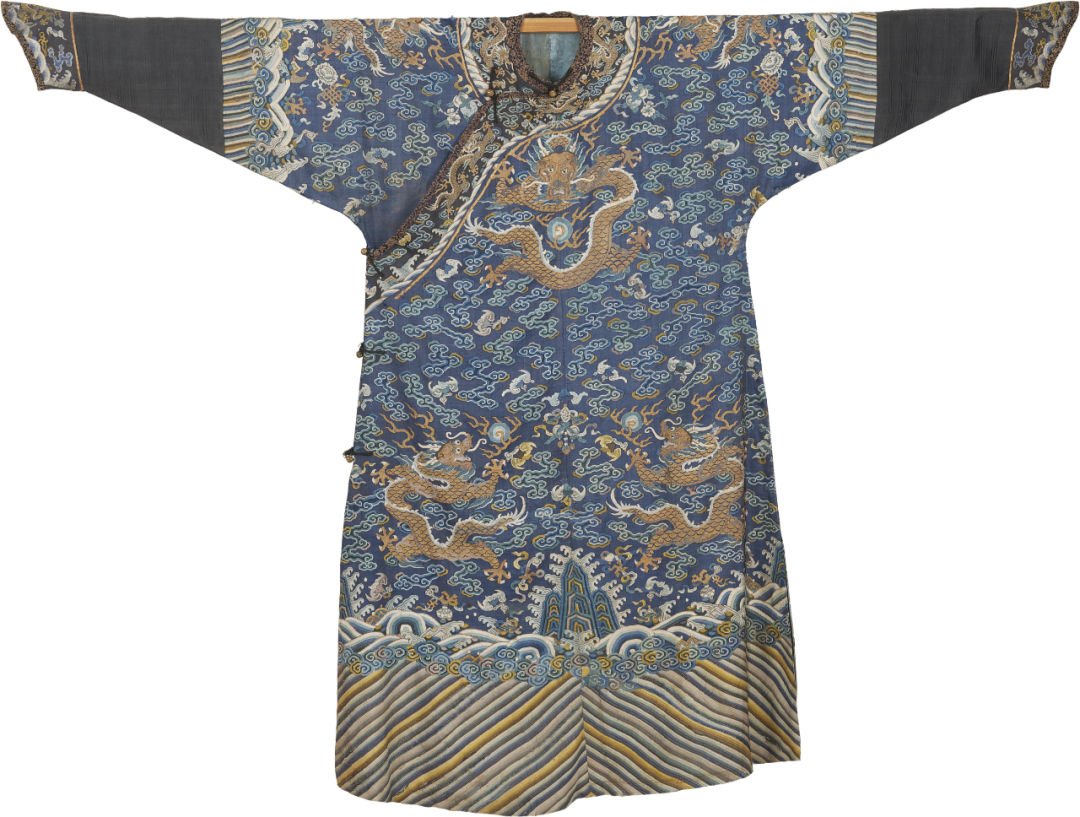
▲ Manchu blue silk brocade robe.
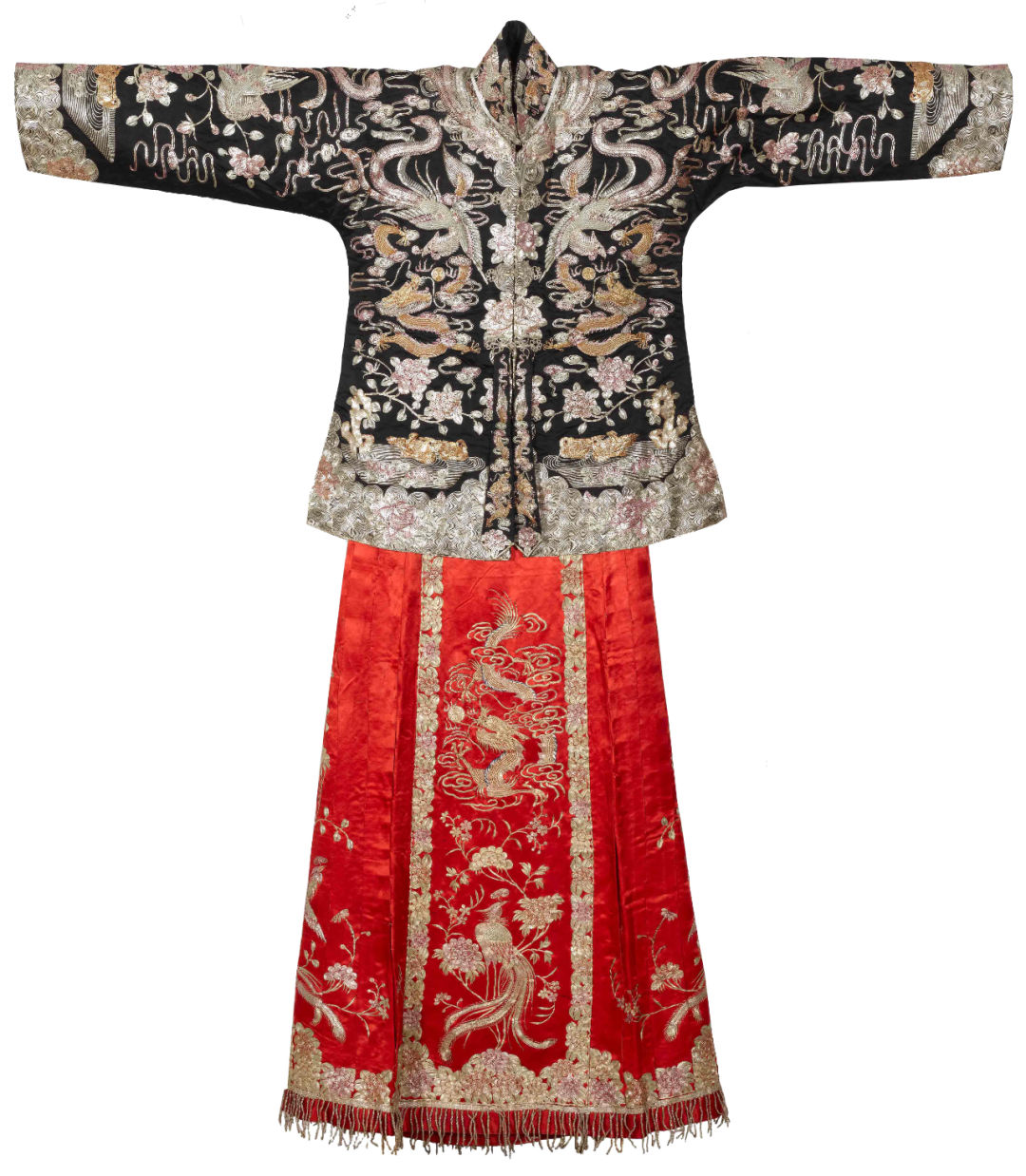
▲ Han people’s flat gold, silver, dragon and phoenix female wedding clothes.
The dragon and phoenix patterns in Zhuang brocade can be divided into figurative and abstract patterns, which are mainly combined forms such as dragon-to-phoenix, dragon-to-phoenix, and double dragon-to-pearl, which together with other animal and plant patterns form a complete pattern. The folk saying of Zhuang nationality, "Ten Zhuang brocade and nine phoenixes are alive like phoenixes coming out of brocade", vividly reflects the Zhuang people’s worship and love for phoenixes.
The brocade of dragon, phoenix, lion and deer pattern of Zhuang nationality in Guangxi is woven with auspicious birds and beasts such as dragon, phoenix, chicken, lion and deer, and the pattern colors of blue, green, red, purple and pink are particularly eye-catching on the orange background. Zhuang people often use flowers instead of pearls for dragon patterns, and the combination of dragon and phoenix and flower tree patterns highlights the exchange and blending of strong and strong folk cultures.
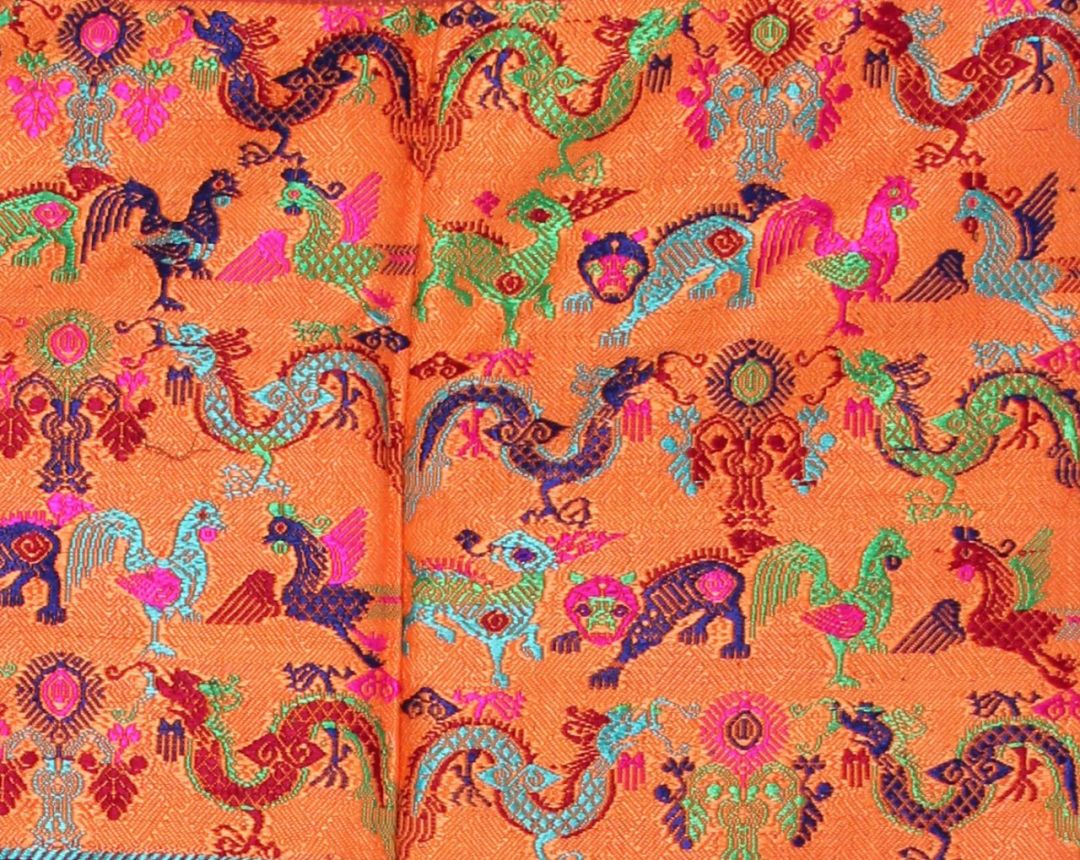
▲ Zhuang nationality dragon and phoenix lion deer brocade pattern.In the costumes of all ethnic groups in China, there are also patterns in which birds replace phoenix.The patterns of dragons and birds in Miao costumes are flexible and changeable. Dragons can be combined with snakes, insects, fish and other animals. Bird patterns include fish-tailed bird patterns and dragon-tailed bird patterns, and the decorative style is full of simple and naive beauty.
The collection of Guizhou Pingyang-style birds’ clothing is a costume worn by the local Miao people during the drum festival. The fabric of the clothing is silk, with silkworm brocade as the base material in the middle of the back, Ping Xiu dragons, birds, phoenixes, fish, butterflies, flowers and other patterns on it, and the ribbon skirt is decorated with white bird feathers and pearl ornaments of Coix seed, which has a strong sense of ceremony and obvious decorative effect.
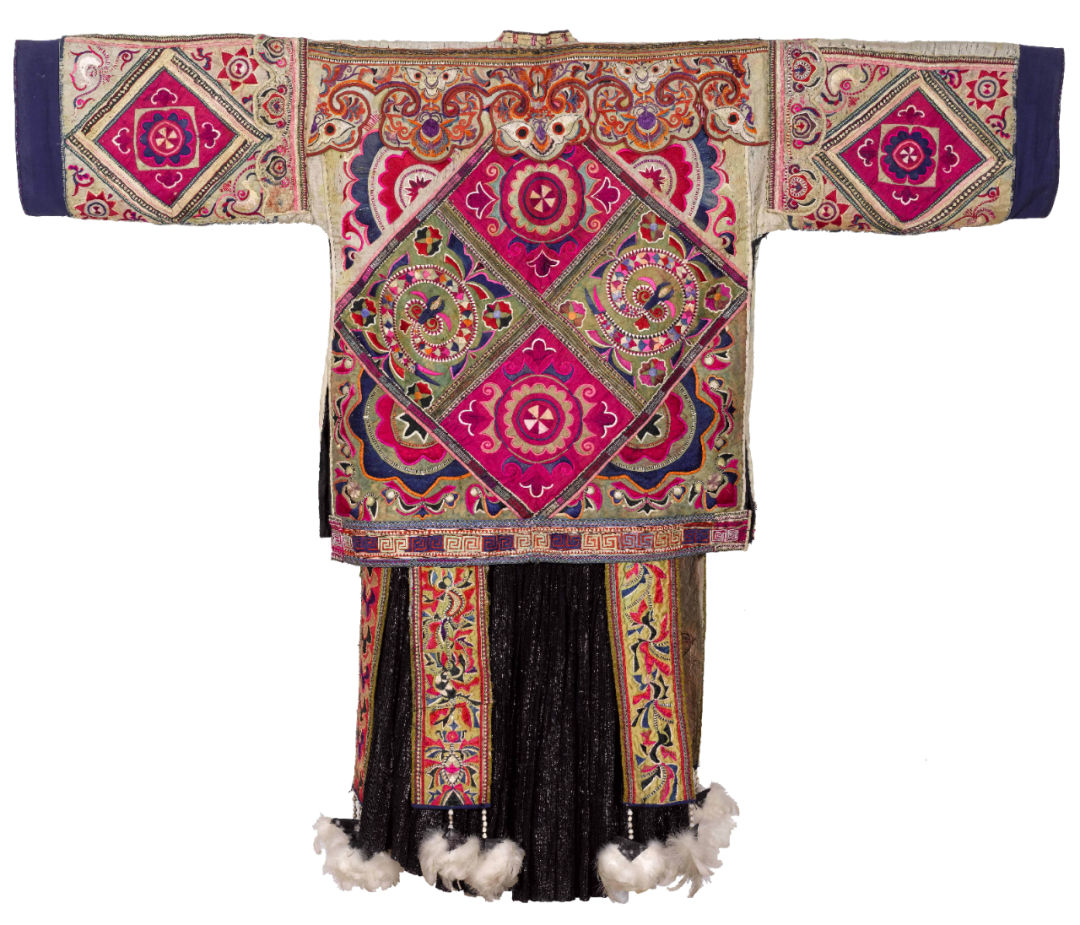
▲ Back view of Miao silkworm brocade bird clothing.
Fu Lu shou Xi
Character decoration with the same origin of painting and calligraphy
Characters are the symbol system used by human beings to record languages, and the art of Chinese characters is an important carrier of Chinese civilization. For thousands of years, the formation and development of the pluralistic and integrated pattern of the Chinese nation has largely benefited from the continuous and in-depth exchanges and exchanges between people of all ethnic groups in the common Chinese characters. This highly symbolic and visualized character has a broad mass base and cultural identity advantages.Therefore, directly decorating auspicious and beautiful words and sentences as patterns has become a major feature of Chinese traditional costume culture.
According to archaeological data and documents, the decorative application of characters on textiles can be traced back to the early Western Han Dynasty. Inherited from generation to generation, especially in the Ming and Qing Dynasties, such characters as Fu, Lu, Shou, Xi, Cai, Gui and Ji were widely used as decorative patterns in clothing and textiles by various ethnic groups because of their direct expression, such as a hundred-year-old picture, a hundred-year-old picture, a double happiness picture and so on. The decorative art of auspicious characters is easy to understand and intuitively reflects the artistic creativity and imagination of people of all ethnic groups.
The collection of Qing Dynasty Han people’s azurite satin embroidered "Fu Ru Dong Hai Shou Bi Nan Shan" pattern belly pocket, the fabric is made of azurite pigment satin, and the center is embroidered with mythical figures and beasts symbolizing longevity, such as Antarctic Xianweng, deer and crane. Around Ping Xiu, the eight Chinese characters "Fu Ru Dong Hai Shou Bi Nan Shan" are embroidered with pomegranate, grapes, preserved melons, bergamot, gourds and peaches, which means many children and many blessings.
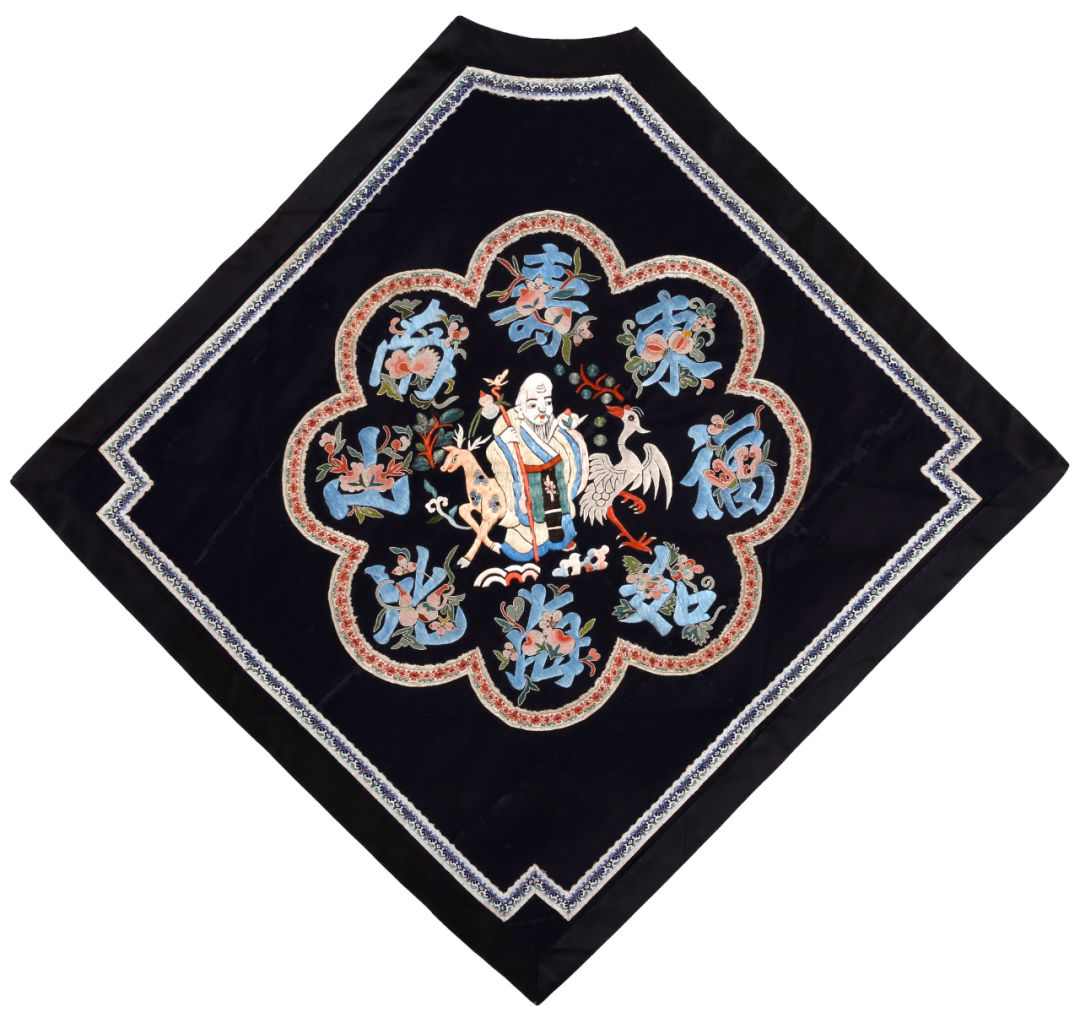
▲ Han azurite satin embroidery "Fu Ru Dong Hai Shou Bi Nan Shan" pattern belly pocket.
In the collection of the Qing Dynasty, the purple silk clothes with the pattern of dark flowers were woven on the purple silk material, and the black satin edge inlaid with the skirt and the white sleeves on the cuffs were embroidered with the word of three blue. "Xi" is an auspicious character formed by the combination of two separate words "Xi", which means "happiness is added to happiness". This garment, in terms of fabric material, pattern theme, embroidery technology and decorative style, reflects the exchange and integration of Han nationality in clothing culture at this time, which also directly affected the etiquette fashion and aesthetic orientation of folk women wearing clothes at that time.
Tujia brocade is also called "Xilankapu", which means "flower bedding". Beautiful brocade, like a girl’s face, is an important way to show diligence, intelligence and personality to relatives and friends, and it is also a necessary dowry at the wedding. Tujia people don’t have their own characters, and they have long used Chinese characters because of their early contact with Han people in history. In Qing dynasty, "returning to the native land" further promoted its exchanges and exchanges with all ethnic groups.
The brocade quilt of Fu Lushou, a Tujia nationality in Hunan Province, is mainly composed of auspicious characters such as Fu, Lu, Shou and Xi, which are filled in the diamond-shaped geometric skeleton, decorated with swastika characters along the border, and set off the character patterns with contrasting colors such as red, green, blue, yellow, blue and white, black and white, and the colors are full and gorgeous.
It is worth mentioning that the brocade arranges the characters in positive and negative mirror symmetry, emphasizing "painting with words" and giving auspicious characters more flexible changes. It is in the process of cultural exchange and blending of all ethnic groups that the diversified and integrated national costume art is formed.
Auspicious figures
till/extremelyHumanistic idea of beauty being good
In national costumes, figure patterns bear a nation’s historical memory and value orientation. The theme of figure patterns in traditional costumes mainly includes mythical figures, historical figures, folk figures and portraits of beautiful women. The story behind the characters has always played a role in rallying people’s hearts and promoting unity in different times.Putting history on the body is not only a symbol to show cultural characteristics, but also to connect the past with the present life and realize the harmony and unity between man and heart.
The collection of Han people’s blue satin multicolored embroidered twelve groups of women’s jackets with wide sleeves is based on the theme of Guo Ziyi, a figure in the Tang Dynasty, and the twelve groups of figures are colored embroidered: the middle of the dress is embroidered with a pattern of Guo Ziyi’s birthday; Embroidered characters on the front sleeve and the bottom show the elegant character of ancient literati through the scene combination of characters touching the piano, playing chess, writing and enjoying paintings. There is an embroidered pattern on the back of the dress to celebrate the birthday of the couple, which shows the scene of Guo Ziyi’s son and daughter-in-law celebrating their birthday hand in hand. There are six embroidery patterns on the shoulders, back sleeves and bottom of the clothes. The figures in the patterns extend the meanings of "three levels of promotion", "high position in the position of Lu", "evergreen", "opening an hundred sons", "good luck in the year" and "sending seals for promotion" through different birthday gifts, and express their feelings.
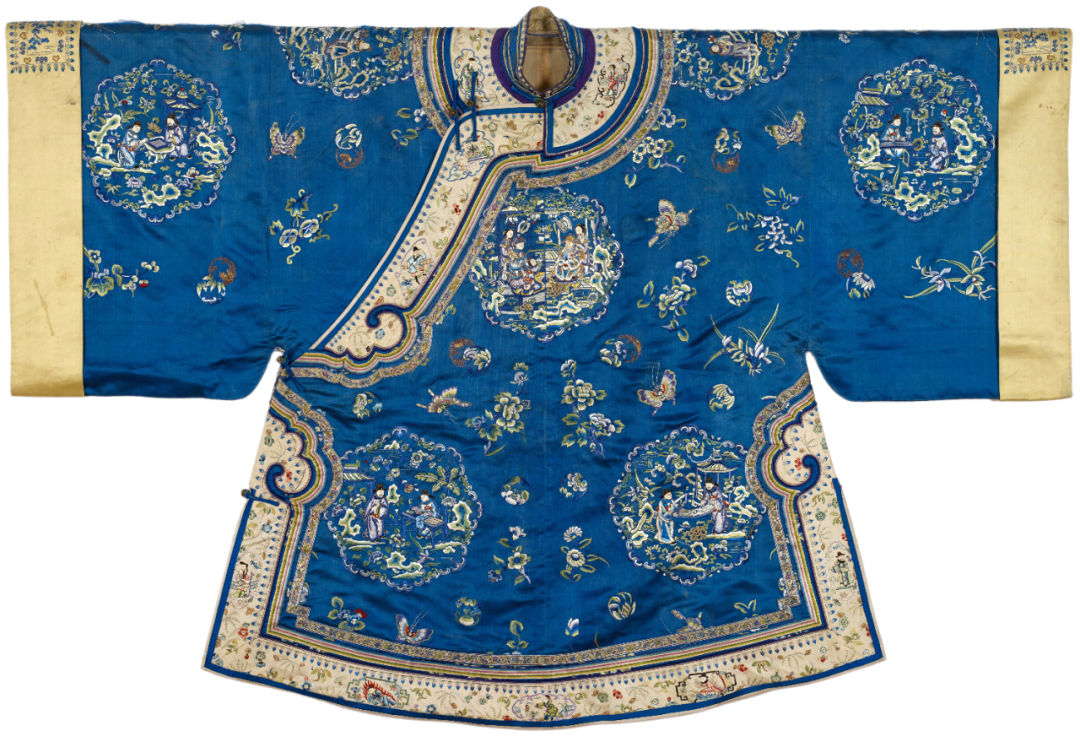
▲ Front view of Han nationality blue satin multicolored embroidered twelve-group-pattern wide-sleeved women’s jacket.
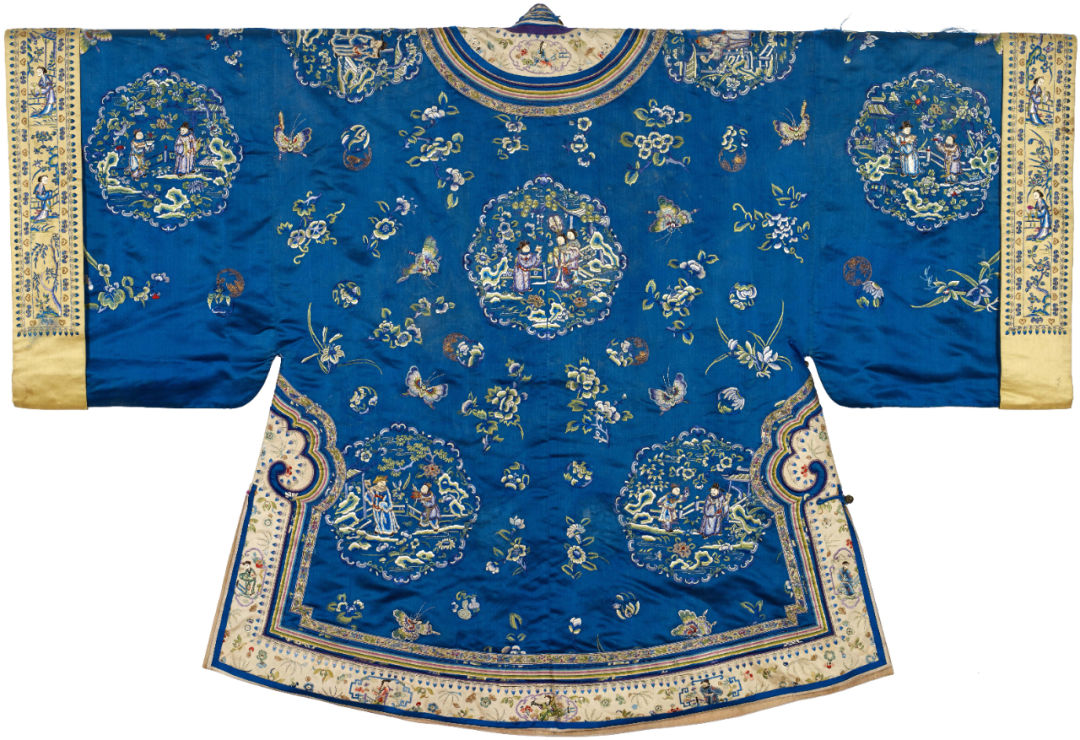
▲ The back view of Han nationality blue satin multicolored embroidered twelve regiments with wide sleeves.
There are many decorative figures in Miao costumes in Qiandongnan Miao and Dong Autonomous Prefecture of Guizhou. The Miao people’s figure-patterned children’s tops in Ping Huang, Guizhou Province are also called "little people’s clothes" or "children’s clothes" locally. The garment body is embroidered with two kinds of ancestor patterns, large and small, which represent the Miao ancestors who protect the family’s peace.
The figure pattern is also the most representative theme in the traditional clothing pattern of Li nationality in Hainan. In the tapestries of five branches of Li dialects, there are many figures depicting ancestor worship, production and life, love and marriage. Among them, in the traditional costumes of Rundialect, the image of ancestors was created into geometric humanoid patterns, and the Li people’s recollection of ancestors was reflected through a large number of repeated layouts.
The Shuang Mianxiu women’s dress in the collection of Li nationality in Hainan is a typical dress of Rundialect women. The pattern style is simple, and it is embroidered by Shuang Mianxiu stitch. The pattern decoration on the dress is concentrated in the easily worn places such as neckline, sleeve edge, sides of the dress and hem, and the stitch is fine, which not only expresses the decorative metaphor, but also reflects the practical function of the pattern.
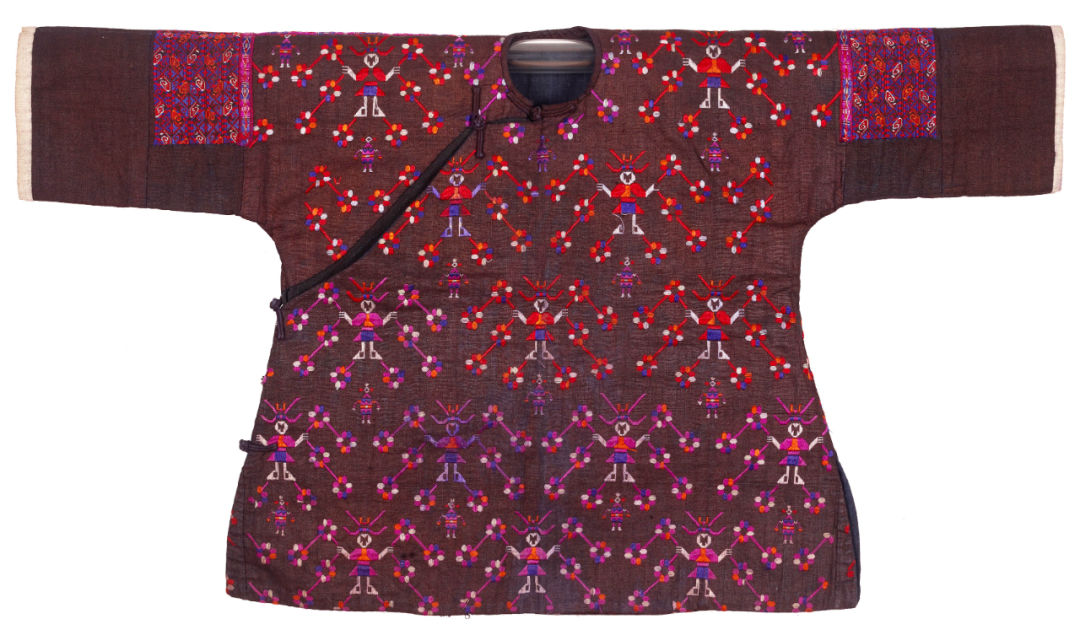
▲ Children’s Tops with Miao Characters in Ping Huang, Guizhou.
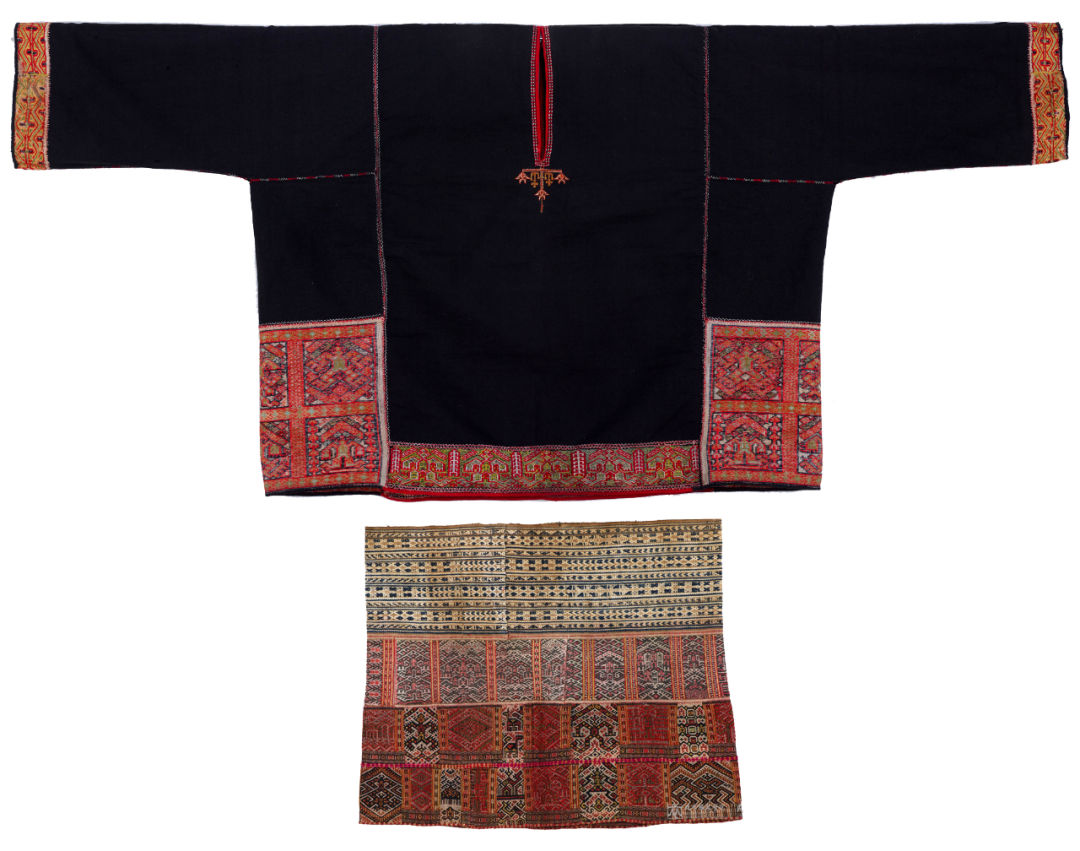
▲ Shuang Mianxiu, a Li nationality in Hainan, wore the first dress.
There is also an auspicious figure pattern created in the traditional costumes of the Han nationality to pray for children’s reproduction and life inheritance — — Baby play pattern. Among the cultural relics in the collection, there are two Zi Ying opera-patterned tops in Qing Dynasty.
One is a red jacquard silk multicolored embroidered group python boy zodiac sea water pattern gown, with 50 sets of baby play patterns embroidered all over. The boy stepped on the pattern of golden flowers and gourds, holding mascots such as Ganoderma lucidum, osmanthus, lotus, blessing characters, copper coins and blessing lanterns, and his expression was vivid and lively.
The other is a double-breasted blouse with flowers, green satin and gold, which is woven into a total of 100 children. They beat drums and gongs, set off firecrackers, or danced with lions and played with fans, and also showed scenes such as Gemini playing lotus and sending officials and blessings. The patterns of the ancient philosophers are supplemented by auspicious patterns such as rich peony, beaming, and Fulu Nanshan.
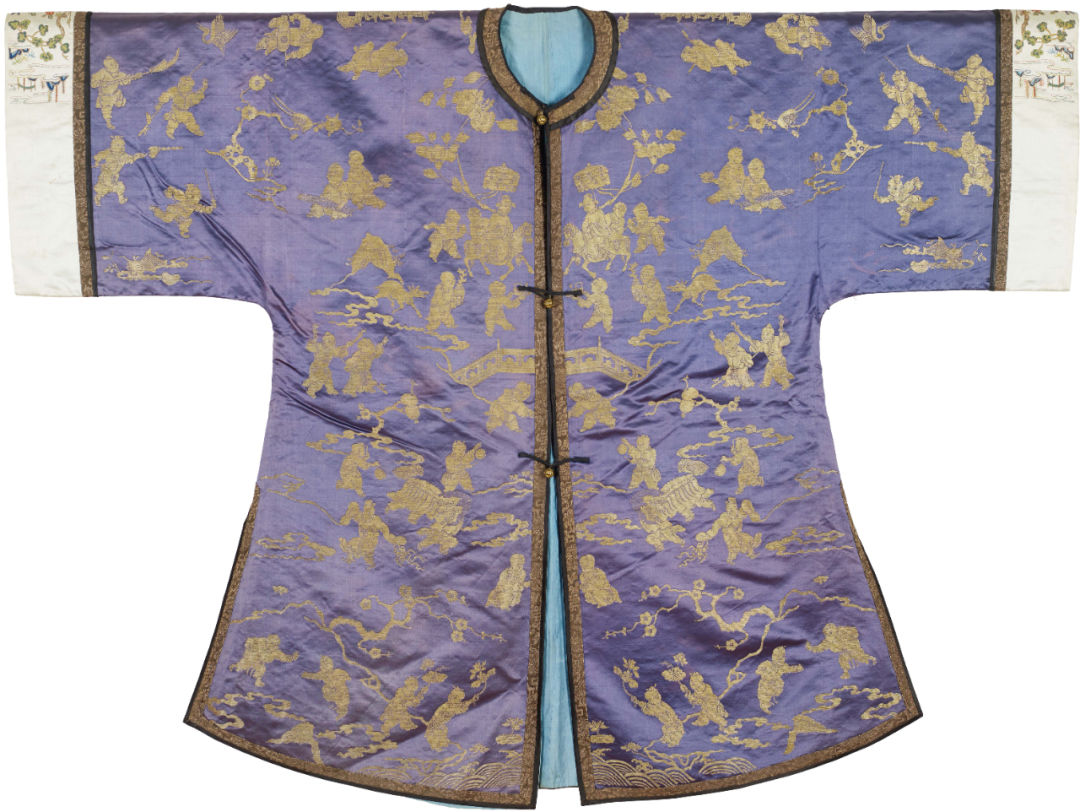
▲ Han nationality flower blue satin woven gold baizi pattern double-breasted female jacket.
Baizi pattern is a pattern that shows children’s play. It originated from the allusion of Zhou Wenwang’s birth of an hundred children in The Book of Songs, and later evolved into a pattern that symbolizes the prosperity of a hundred children and a thousand grandchildren. It is a very popular pattern theme among the people, and it is also a well-established auspicious decoration on wedding utensils in the Ming and Qing Dynasties. Many pieces of ancient clothes worn by the Empress were also unearthed in Dingling of Ming Dynasty in Beijing, which reflected the concept of praying for happiness in all levels of agricultural civilization.
(The pictures in this article are provided by the National Costume Museum of Beijing Institute of Fashion. Authors: Gao Dandan, Yuan Zonggang, Tian Hui, National Costume Museum of Beijing Institute of Fashion Technology. This article was published in the first issue of China Nationality magazine in 2023. )